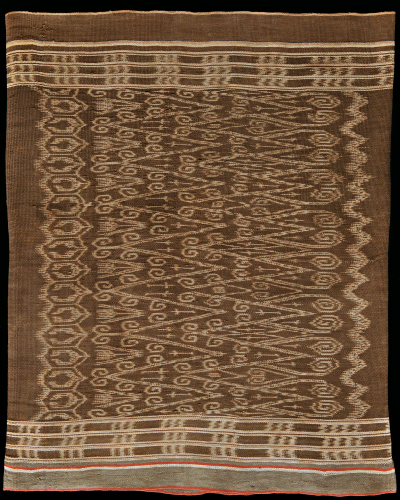| |
230 Borneo, Kalimantan
Kain kebat (skirt)  
|
| Locale: | Mualang |
| Period: | Late 19th to early 20th c. |
| Yarn: | Cotton, hand-spun, very fine, twice twined |
| Technique: | Warp ikat |
| Panels: | 1 |
| Size: | 53.5 x 70 cm (1' 9" x 2' 3") LW: 1.31 |
| Weight: | 305 g (10.8 oz), 407 g/m2 (1.33 oz/ft2) |
| Design: | Tree of Life motif. While Kalimantan weavers generally work with basic ikated motifs repeated three or four times, here no repeat appears to have been used. |
| Comment: | Early Mualang skirt done in the chocolaty colour of enkerbai that is typical for Mualang - as opposed to the redder engkudu (morinda) used by most other Ibanic weavers. Much of the ikat work consists of motifs in lines only three threads wide. Kalimantan weavers usually work with a warp bed folded over three or four times to limit the size of the basic ikated motif. The yarn (see microscopic images) is unusual: the weaver span very fine yarn, then twined it for strength, and then twined it with another length of the same two-ply yarn - though not countered, but winding in the same direction. This was done both for warp and weft. It has given the cloth a finely ribbed surface. Origin and motif confirmed, respectively identified, by Chandra Iban Kantuk. Ex collection Baron Frederic Rolin. |
| Background: | Chapters on Borneo and Kalimantan. |
| Compare: | 212 220 229 241 242 |
| Sources: | No close cognates known, except a kain kebat worn by the temporary wife of adventurer Jean-Yves Domalain, photographed circa 1970, in a region on the border between Sarawak and Kalimantan that he wandered into and never could identify by name or location, but that was most likely Mualang territory. Domalain, Panjamon: I Was a Headhunter.
 |
| |

©Peter ten Hoopen, 2025
All rights reserved.
|


